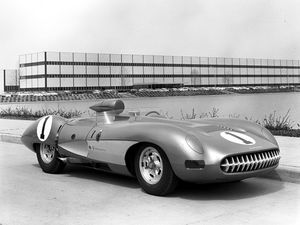.
Corvette XP-64 concept racer: Difference between revisions
Bill Wrigley (talk | contribs) (→Design) |
Bill Wrigley (talk | contribs) |
||
| Line 38: | Line 38: | ||
== Power plant == | == Power plant == | ||
Under the hood lay a bored out, high output Chevrolet 283 in³ small-block engine with aluminium heads. This high compression variant was modified with a long-duration cam and was fuel injected. Total output was 307 bhp at 6400 RPM. Gearing was controlled through a 4-speed | Under the hood lay a bored out, high output Chevrolet 283 in³ small-block engine with aluminium heads. This high compression variant was modified with a long-duration cam and was fuel injected. Total output was 307 bhp at 6400 RPM. Gearing was controlled through a 4-speed transmission. | ||
{|border=1 | {|border=1 | ||
Revision as of 01:11, 23 January 2007
| 1957 Corvette SS concept racer | |
|---|---|
| General Motors | |
| aka | XP-64<ref>"XP" was a GM designation for experimental (XP) concept cars.</ref>, Super Spyder<ref>Corvette Museum</ref>, Sebring SS |
| Production | concept |
| Class | Sebring racer |
| Body type | 2-door, 2-seater, canopy roadster |
| Engine | Chevrolet V-8 OHC, aluminium heads |
| Power | 307 bhp |
| Succeeded | 1958 Corvette |
| Designer | Zora Arkus-Duntov |
The Corvette XP-64 was a purpose-built, two-seater race car that was designed at Chevrolet's high-performance division exclusively to go up against Ferrari, Maserati and Porsche in the Grand Prix, endurance class at Sebring in 1957. The XP-64 was an experimental car, a two door, canopy roadster that incorporated an aerodynamic body over a lightweight chassis. It was built in 1956 by renowned automotive engineer Zora Arkus-Duntov for debut the following year.
Design
The design of the XP-64 borrowed heavily from the stylings of the D-type Jaguar, employing a wind-tunnel inspired monocoque that was made from lightweight magnesium<ref>November 16, 1956 Chronology of Chevrolet Corvettes - Copyright © 1995-2007 Ken Polsson</ref> fitted to a rigid space-frame weighing a mere 150 pounds. Retractable headlights, like those on later Corvettes, a low-profile, wrap-around windscreen, and an impressive, teardrop-shaped headrest that ran the entire length of the rear deck were it’s most distinguishing features. The interior was bare-bones, with functional instruments that included a clock, installed to monitor the the long, endurance races at Le Mans and Sebring. The car was painted blue with white roundals, as per USA's colors in international road racing.
Power plant
Under the hood lay a bored out, high output Chevrolet 283 in³ small-block engine with aluminium heads. This high compression variant was modified with a long-duration cam and was fuel injected. Total output was 307 bhp at 6400 RPM. Gearing was controlled through a 4-speed transmission.
| Engine name | Engine type | Displacement in³ ( L) | Output bhp (kW) @ RPM | Torque Ft-Lbs (Nm) @ RPM | Carburetor series (bbl) |
| "XP-64"-8 | V-8 | 283 (4.6) | 307.00 (226)<ref>Concept Carz</ref> @ 6400 | NA (NA) @ 2000.00 | Fuel injection<ref>(month unknown) Chronology of Chevrolet Corvettes - Copyright © 1995-2007 Ken Polsson</ref> |
Trivia
- Builder Zora Arkus-Duntov originally had orders to build four individual racers but eventually was limited to just one, due to difficulties in acquiring enough magnesium sheets that were used throught the body.
Footnotes
<references/>

